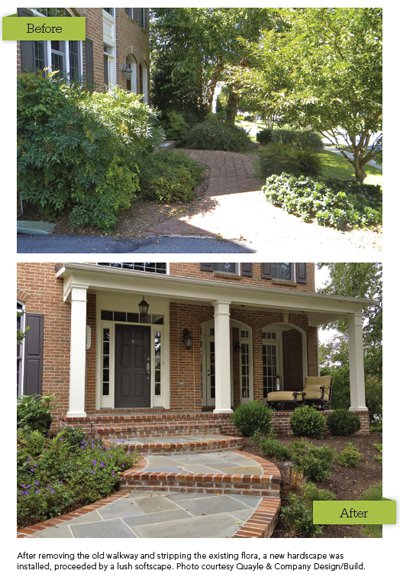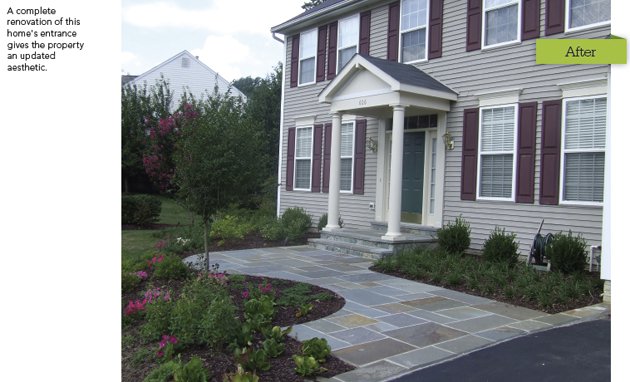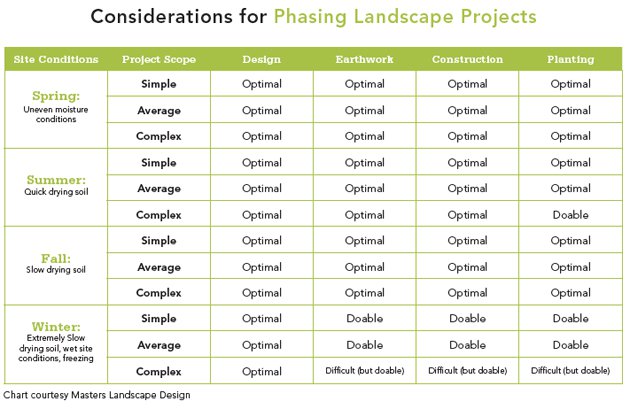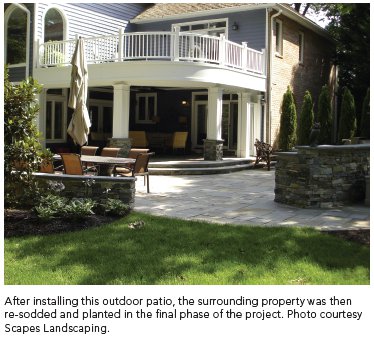Hardscape installs, such as patios, retaining walls, and driveways, are then followed by softscapes, including flora, garden beds, and mulching. Photos courtesy Ciminelli's Landscape Services.
By Kevin J. Kohler
With concrete jungles seemingly everywhere these days, homeowners may have a greater desire than ever to create sanctuaries out of their yards. But major transformations may require them to dig deeper into their wallets. Fortunately, landscape design builders can help homeowners realize their vision by eaking down such projects into phases completed (and paid for) over a sensible time frame.
After World War II, people began to move from the front porch to the back yard, building decks, patios, backyard pools, and so forth. The outdoor living room was born, and as folks spent more time out of their houses, they came to desire more amenities like outdoor kitchens, fire pits, screened rooms, and cabanas. Of course, curb appeal has always been a factor. As a way to manage costs, phasing gained popularity in the early ’80s.
“Breaking out a design into phases in order to achieve your landscape goals has been around for a long time, but with the last recession, more homeowners are choosing smaller phases instead of biting off the whole master plan at once,” says Hal Quayle, who owns a local design/build company in Severna Park. Vicki Metzger of another landscaping company agrees. “It has become even more popular now because peoples' budgets are tight.” Regardless, the key to success involves careful consideration of every aspect of the endeavor with a professional who can lead you through it.
A Solid Foundation
Though it's easy to want changes made, figuring out what, when, and how can be daunting. “Clients often don't even know what their house looks like,” says Emily Livermore, an executive assistant with an Annapolis-based landscaper. “They see it every day. We give them a new perspective.”
After videoing a property, the company uses a Smart Board to show a virtual tour of the client’s wishes, wants, and desired changes. Virtual collaboration leads to better choices, solutions, and decisions for phasing in a project.
Bob Masters, company president of the Annapolis firm, says there are four main items to consider as game plans begin: the scope of the project, the money available at particular times, the client's desired time line, and the changing seasons. It's important to be honest, not leaving any items to mention later, as it could greatly impact the efficiency and costs associated with implementation.
While each firm may approach a property a bit differently based on their resources (construction and nursery suppliers, for example), there is a typical hierarchy of procedures—a method to the madness many see as workers descend on a property. After unwanted elements, such as trees, are removed, “under earth” items are addressed, including foundations, piping for pools or irrigation, lighting, and so forth. Then there are paved items and other hardscapes (patios, gazebos, retaining walls), followed by softscapes, which include flora, ideally planted according to season.
“Unlike building a house, the landscape process lends itself to being done in phases; it gives homeowners a chance to get the environment they’ve always wanted without blowing their budget,” Metzger says.
Within the scope of the project, how much excavation and grading will be required is particularly important, as it involves large machinery, which raises costs with multiple trips. If the work is to be done in conjunction with a house renovation, it may be pushed to another season, when the clients have more funds available.
Clients often wish to avoid interrupting their summer lifestyles, but as Livermore notes, “People generally think it takes longer than it does. Then they say, ‘Oh my, you did that so fast.’”
While clients have a number of things on their minds, landscape builders are focused on one or two related to the earth itself. Soil moisture and temperature vary greatly based on the season, and rain or snow can make certain tasks next to impossible. January through April is the most challenging season, according to Masters. Fall is ideal with landscape construction in winter. Seasons also affect species availability and planting itself. Even with the possibility of using tents to create microclimatic conditions, all these things have to be factored in to the overall equation. Such measures can increase the cost by 5 to 10 percent of the total project.
Digging In
Before work is started and pricing is set, the property’s environment also will be considered. “Topography can dictate phasing,” Masters says. Whether the estate is in an urban, suburban, waterfront, woodland, or country setting will significantly impact space use and traffic flow. For example, waterfront planting must be done according to a tight schedule to avoid problems. So choosing a window that makes the most sense is an important service landscape designers can provide.
“Clients today are careful in their decisions and are very involved in the design process,” Quayle says. It makes sense to do as much as possible together, so the planning phase is the most important one and shouldn't be rushed. With some firms, the price of material can vary depending the season and economy, so asking a lot of questions is important.
It’s also become especially common to group work by area. Masters says if you have to phase, it’s typically best to go from the backyard to the sideyard, and finally to the front.
In addition to budgeting and accommodating client time frames, phasing allows for adjustments along the way. “You can start to get a feel for your landscape before everything is complete and make any necessary changes,” Quayle says.
“A phased project is cohesive and makes it look like it was completed all at once,” says Metzger, who advises to make sure that the plan is yours, regardless of who implements it. Clients should expect to pay for the designer’s time to complete the plan and any revisions required, while keeping in mind that wants and needs typically evolve as work progresses. Flexibility is key.
It’s important for clients to do their homework so as to determine what’s best for them. “A lot of client’s don't have a good vision of what the finished product will look like. Seeing completed jobs and talking to references is important,” says Jeff Candrell, owner of another local landscaping company.
“Everybody wishes they could have their dream yard/landscape installed right now and start
enjoying it, but that is not reality for a lot of us,” Quayle says. “Clients who choose to eak out their landscape into phases are extremely pleased because the end result is the same whether they had it installed all at once or installed in multiple phases. The key to making it work is communication.”
Special thanks to several landscaping companies and personnel for contributing information and photographs on phase-in landscaping. They are: Masters Landscape Design; Quayle & Company Design/Build; Scapes Landscaping; Ciminelli's Landscape Services; and Relms Landscaping.




